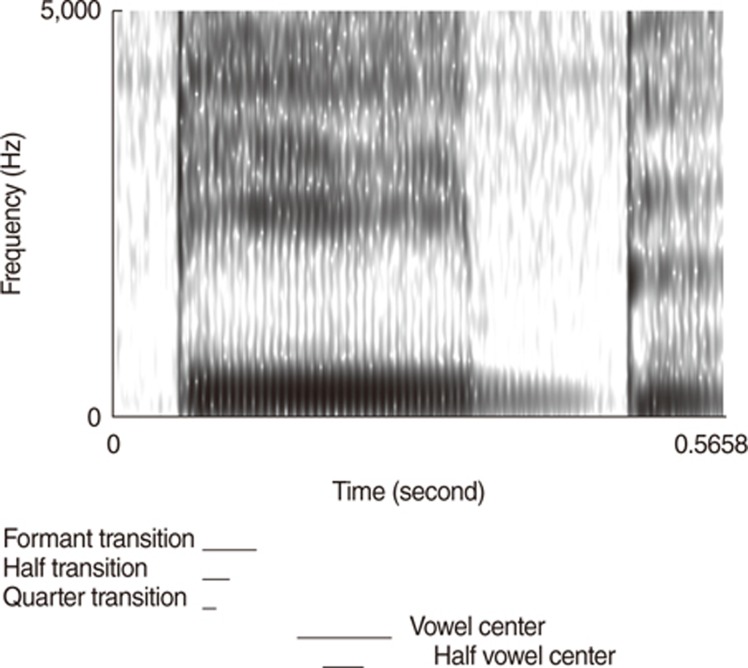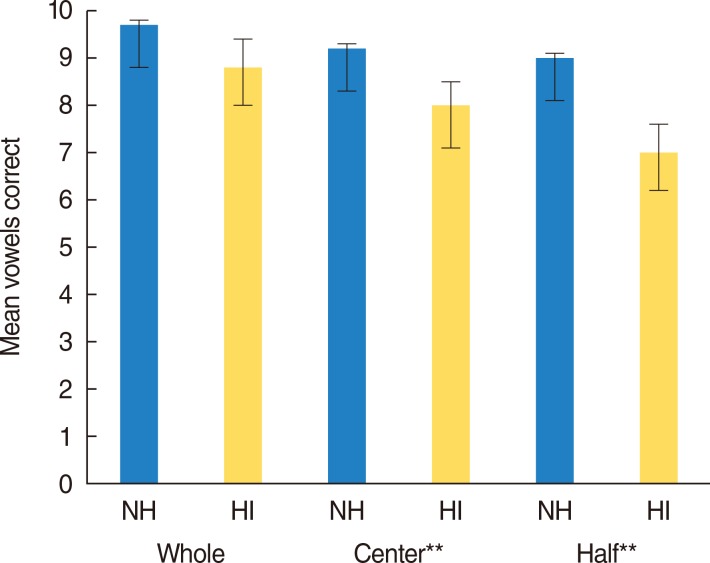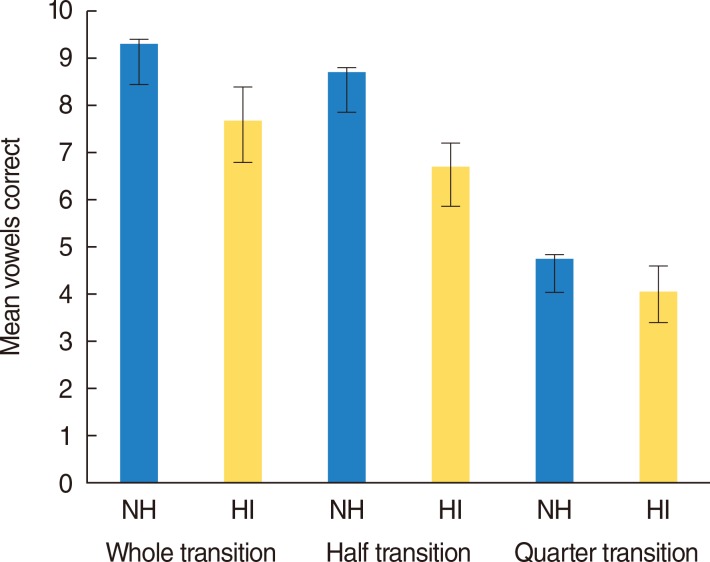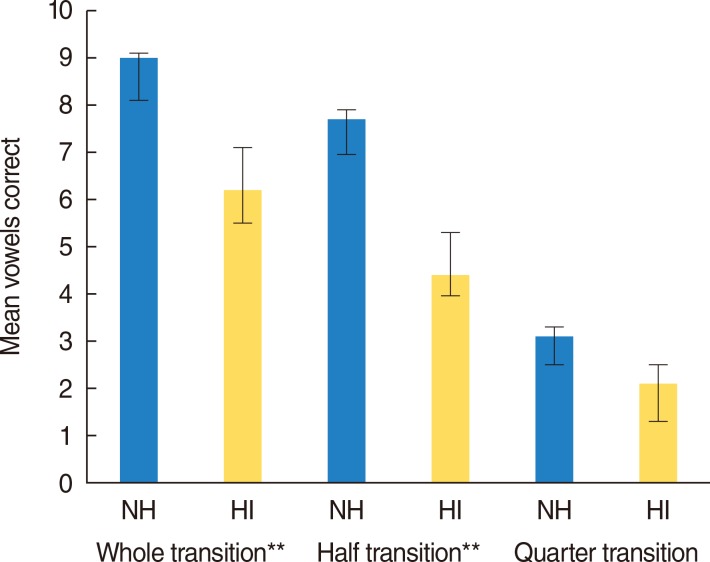Clin Exp Otorhinolaryngol.
2015 Mar;8(1):26-33. 10.3342/ceo.2015.8.1.26.
Vowel Perception in Listeners With Normal Hearing and in Listeners With Hearing Loss: A Preliminary Study
- Affiliations
-
- 1Department of Audiology & Speech Pathology, The University of Tennessee Health Science Center, Knoxville, TN, USA. mhedric1@utk.edu
- KMID: 1973484
- DOI: http://doi.org/10.3342/ceo.2015.8.1.26
Abstract
OBJECTIVES
To determine the influence of hearing loss on perception of vowel slices.
METHODS
Fourteen listeners aged 20-27 participated; ten (6 males) had hearing within normal limits and four (3 males) had moderate-severe sensorineural hearing loss (SNHL). Stimuli were six naturally-produced words consisting of the vowels /i a u ae epsilon / in a /b V b/ context. Each word was presented as a whole and in eight slices: the initial transition, one half and one fourth of initial transition, full central vowel, one-half central vowel, ending transition, one half and one fourth of ending transition. Each of the 54 stimuli was presented 10 times at 70 dB SPL (sound press level); listeners were asked to identify the word. Stimuli were shaped using signal processing software for the listeners with SNHL to mimic gain provided by an appropriately-fitting hearing aid.
RESULTS
Listeners with SNHL had a steeper rate of decreasing vowel identification with decreasing slice duration as compared to listeners with normal hearing, and the listeners with SNHL showed different patterns of vowel identification across vowels when compared to listeners with normal hearing.
CONCLUSION
Abnormal temporal integration is likely affecting vowel identification for listeners with SNHL, which in turn affects vowel internal representation at different levels of the auditory system.
Keyword
Figure
Reference
-
1. Peterson GE, Barney HL. Control methods used in a study of vowels. J Acoust Soc Am. 1952; 3. 24(2):175–184.2. Ohde RN, German SR. Formant onsets and formant transitions as developmental cues to vowel perception. J Acoust Soc Am. 2011; 9. 130(3):1628–1642. PMID: 21895100.
Article3. Strange W. Evolving theories of vowel perception. J Acoust Soc Am. 1989; 5. 85(5):2081–2087. PMID: 2659637.
Article4. Strange W, Jenkins JJ, Johnson TL. Dynamic specification of coarticulated vowels. J Acoust Soc Am. 1983; 9. 74(3):695–705. PMID: 6630725.
Article5. Kuwabara H. An approach to normalization of coarticulation effects for vowels in connected speech. J Acoust Soc Am. 1985; 2. 77(2):686–694. PMID: 3973240.
Article6. Molis MR, Leek MR. Vowel identification by listeners with hearing impairment in response to variation in formant frequencies. J Speech Lang Hear Res. 2011; 8. 54(4):1211–1223. PMID: 21297168.
Article7. Richie C, Kewley-Port D, Coughlin M. Discrimination and identification of vowels by young, hearing-impaired adults. J Acoust Soc Am. 2003; 11. 114(5):2923–2933. PMID: 14650026.
Article8. Bacon SP, Brandt JF. Auditory processing of vowels by normal-hearing and hearing-impaired listeners. J Speech Hear Res. 1982; 9. 25(3):339–347. PMID: 7176605.
Article9. Kewley-Port D, Burkle TZ, Lee JH. Contribution of consonant versus vowel information to sentence intelligibility for young normal-hearing and elderly hearing-impaired listeners. J Acoust Soc Am. 2007; 10. 122(4):2365–2375. PMID: 17902871.
Article10. Arehart KH, Rossi-Katz J, Swensson-Prutsman J. Double-vowel perception in listeners with cochlear hearing loss: differences in fundamental frequency, ear of presentation, and relative amplitude. J Speech Lang Hear Res. 2005; 2. 48(1):236–252. PMID: 15938067.11. Rosen S. Temporal information in speech: acoustic, auditory and linguistic aspects. Philos Trans R Soc Lond B Biol Sci. 1992; 6. 336(1278):367–373. PMID: 1354376.12. Bidelman GM, Heinz MG. Auditory-nerve responses predict pitch attributes related to musical consonance-dissonance for normal and impaired hearing. J Acoust Soc Am. 2011; 9. 130(3):1488–1502. PMID: 21895089.
Article13. Swaminathan J, Heinz MG. Predicted effects of sensorineural hearing loss on across-fiber envelope coding in the auditory nerve. J Acoust Soc Am. 2011; 6. 129(6):4001–4013. PMID: 21682421.
Article14. American National Standards Institute. Specification for audiometers (S3.6-2010). New York: American National Standards Institute;2010.15. Viemeister NF, Wakefield GH. Temporal integration and multiple looks. J Acoust Soc Am. 1991; 8. 90(2 Pt 1):858–865. PMID: 1939890.
Article16. Holt RF, Carney AE. Multiple looks in speech sound discrimination in adults. J Speech Lang Hear Res. 2005; 8. 48(4):922–943. PMID: 16378483.
Article17. Moore BC. Temporal integration and context effects in hearing. J Phon. 2003; Jul-Oct. 31(3-4):563–574.
Article18. McCaffrey HA, Sussman HM. An investigation of vowel organization in speakers with severe and profound hearing loss. J Speech Hear Res. 1994; 8. 37(4):938–951. PMID: 7967578.
Article19. Alain C, Reinke K, He Y, Wang C, Lobaugh N. Hearing two things at once: neurophysiological indices of speech segregation and identification. J Cogn Neurosci. 2005; 5. 17(5):811–818. PMID: 15904547.
Article20. Griffiths TD, Warren JD. The planum temporale as a computational hub. Trends Neurosci. 2002; 7. 25(7):348–353. PMID: 12079762.
Article21. McKeown JD. Perception of concurrent vowels: the effect of varying their relative level. Speech Commun. 1992; 3. 11(1):1–13.22. Warren JD, Jennings AR, Griffiths TD. Analysis of the spectral envelope of sounds by the human brain. Neuroimage. 2005; 2. 24(4):1052–1057. PMID: 15670682.
Article23. Nabelek AK, Czyzewski Z, Krishnan LA. The influence of talker differences on vowel identification by normal-hearing and hearing-impaired listeners. J Acoust Soc Am. 1992; 9. 92(3):1228–1246. PMID: 1401512.24. Hedrick MS, Schulte L, Jesteadt W. Effect of relative and overall amplitude on perception of voiceless stop consonants by listeners with normal and impaired hearing. J Acoust Soc Am. 1995; 9. 98(3):1292–1303. PMID: 7560503.
Article25. Kewley-Port D, Goodman SS. Thresholds for second formant transitions in front vowels. J Acoust Soc Am. 2005; 11. 118(5):3252–3260. PMID: 16334904.
Article26. Gaskell MG, Marslen-Wilson WD. Integrating form and meaning: a distributed model of speech perception. Lang Cogn Process. 1997; 12(5/6):613–656.
Article
- Full Text Links
- Actions
-
Cited
- CITED
-
- Close
- Share
- Similar articles
-
- The Acceptable Noise Level Benefit From Directionality for Listeners With Severe Hearing Loss
- Factors Affecting Sentence-in-Noise Recognition for Normal Hearing Listeners and Listeners with Hearing Loss
- Music Perception Ability of Korean Adult Cochlear Implant Listeners
- Horizontal Sound Localization and Spatial Short-Term Memory Span in Hearing-Impaired Listeners and Listeners With Simulated Hearing Loss
- Comparison of 50% Recognition Signal-to-Noise Ratio Using a Multi-Talker Babble Noise in Normal-Hearing and Hearing-Impaired Individuals





